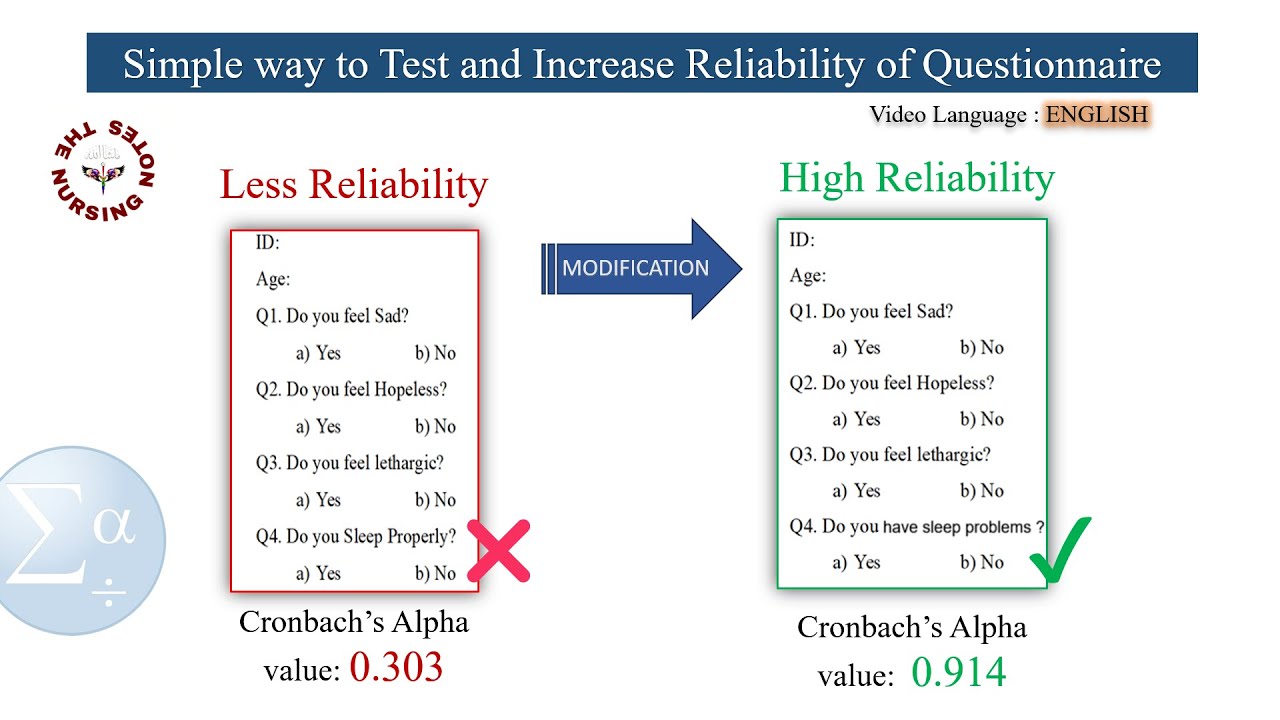Cronbach's Alpha - Excel
TLDRThe video script discusses the importance of measuring the internal consistency of a scale or questionnaire, which is crucial for assessing the reliability of a set of questions designed to measure a particular construct. The speaker uses the example of a math teacher assessing students' comprehension of trigonometry through an exam with multiple questions. The concept of internal consistency implies that all questions on the exam relate to the same topic. To statistically measure this consistency, the video introduces Cronbach's Alpha, a widely used measure that produces a value between 0 and 1. A high Cronbach's Alpha value indicates strong internal consistency. The speaker demonstrates how to calculate Cronbach's Alpha using Excel and a dataset from a hypothetical questionnaire with 14 questions based on a 5-point Likert scale. The calculation results in a Cronbach's Alpha of 0.99, suggesting very high internal consistency. The video concludes by noting that a Cronbach's Alpha value of 0.75 or higher is generally considered acceptable for research purposes, and that while a high value is desirable, it may also indicate redundancy in questions, which could be streamlined for efficiency.
Takeaways
- 📚 **Importance of Internal Consistency**: Measuring the internal consistency of a scale or questionnaire is crucial to ensure that all questions are assessing the same underlying construct.
- 👨🏫 **Example Scenario**: The video uses a math teacher assessing students' understanding of trigonometry as an example to illustrate the need for internal consistency in a set of questions.
- 📊 **Cronbach's Alpha**: Introduces Cronbach's alpha as a widely used statistical measure to assess the internal consistency of a scale, producing a value between 0 and 1.
- 🚫 **Negative Values**: Negative values in Cronbach's alpha suggest that scale items may have been reverse scored, which is typically not desired.
- 🔢 **Scale Components**: The formula for Cronbach's alpha involves the number of items in the scale and the variance of individual items and total scores.
- 📈 **Calculating Variance**: The video demonstrates how to calculate the variance for each question and the total score variance, which are components of the Cronbach's alpha formula.
- 📋 **Data Collection**: Emphasizes the necessity of testing a new scale or exam with a preliminary group of subjects to gather data for internal consistency analysis.
- 📉 **High Cronbach's Alpha**: A high Cronbach's alpha value, such as 0.99 in the example, indicates a very high level of internal consistency among the questions.
- 🔍 **Research Standards**: In research, a Cronbach's alpha of 0.75 or higher is often considered acceptable for the scale to be used and published.
- 🔨 **Redundancy Consideration**: A very high alpha value might suggest redundancy in questions, indicating that some questions may not be necessary and could be removed to streamline the scale.
- 📝 **Practical Application**: The video provides a step-by-step guide on how to calculate Cronbach's alpha using Excel, making it a practical tool for assessing internal consistency.
- 📚 **Further Learning**: Encourages viewers to subscribe, share, and explore more tutorial videos on data science, analytics, mathematics, and statistics for further understanding.
Q & A
Why is it important to measure the internal consistency of a scale or questionnaire?
-Measuring internal consistency is important because it ensures that all questions within a scale or questionnaire are related to the same overarching topic or construct. This helps in assessing the comprehension or attitudes accurately and ensures the reliability of the results.
What is the running example used in the video to explain internal consistency?
-The running example used is a math teacher assessing students' comprehension of trigonometry through an exam with multiple questions. The exam's internal consistency is crucial to ensure all questions are about trigonometry.
What does the term 'internal consistency' imply in the context of a scale or questionnaire?
-Internal consistency implies that all questions in a scale or questionnaire are focused on a single topic or construct, ensuring that they are measuring the same underlying concept or trait.
What is Cronbach's alpha, and how is it used?
-Cronbach's alpha is a statistical measure used to assess the internal consistency of a set of scale or test items. It produces a value between 0 and 1, with higher values indicating a higher level of internal consistency among the items.
What does a Cronbach's alpha value of 0.99 suggest about the scale or questionnaire?
-A Cronbach's alpha value of 0.99 suggests an extremely high level of internal consistency among the items in the scale or questionnaire, indicating that the questions are highly related and measure the same concept effectively.
What is the general threshold for Cronbach's alpha values in research?
-In research, a Cronbach's alpha value of 0.75 or higher is generally considered as indicative of a scale being internally consistent and reliable for further use and publication.
What is a potential issue with a very high Cronbach's alpha value?
-A very high Cronbach's alpha value might suggest redundancy in the questions, indicating that some questions may not be contributing unique information to the understanding of the construct, which could lead to a less efficient scale.
How many subjects were involved in the preliminary run of the exam in the provided example?
-In the provided example, 20 subjects were involved in the preliminary run of the exam to assess the internal consistency of the scale.
What was the scale of measurement used for the questionnaire in the video?
-The scale of measurement used for the questionnaire was a five-point Likert scale, where responses ranged from 1 (strongly disagree) to 5 (strongly agree), with 0 or 3 and 4 representing neutral or somewhat neutral responses.
How does one calculate the sum of the item variances in the context of Cronbach's alpha?
-To calculate the sum of the item variances, one needs to compute the variance for each individual question or item across all subjects and then sum these variances together.
What is the formula for calculating Cronbach's alpha?
-The formula for calculating Cronbach's alpha is: α = (K / (K - 1)) * (1 - (Σitem variances) / total score variance), where K is the number of items, Σitem variances is the sum of variances for each item, and total score variance is the variance of the total scores across all subjects.
What is the significance of the number of components in the Cronbach's alpha formula?
-The number of components (K) in the Cronbach's alpha formula represents the total number of questions or items in the scale or questionnaire. It is used as a scaling factor in the formula to adjust the overall measure of internal consistency.
Outlines
📚 Understanding Internal Consistency in Assessments
This paragraph introduces the concept of internal consistency in scales or questionnaires. It explains why we use multiple questions in an exam to assess a single topic comprehensively. The example of a math teacher assessing students' understanding of trigonometry is used to illustrate this point. The paragraph also touches on the use of scales by researchers to measure constructs like attitudes towards immigration policy. It concludes with an introduction to Cronbach's alpha as a statistical measure for assessing internal consistency, with an explanation of its significance and how values are interpreted.
📊 Calculating Cronbach's Alpha for Internal Consistency
The second paragraph delves into the actual calculation of Cronbach's alpha using Excel. It outlines the dataset being used, which includes 20 subjects who answered a 14-item questionnaire based on a five-point Likert scale. The paragraph explains the need to calculate the number of items, the sum of item variances, and the variance of total scores. It guides through the process of using these components in the Cronbach's alpha formula to assess the internal consistency of the scale. The paragraph ends with a discussion on the implications of the results, noting that a high Cronbach's alpha value might indicate redundancy in questions.
🎓 Interpreting Cronbach's Alpha Results and Next Steps
The final paragraph discusses the interpretation of the Cronbach's alpha result, which in the provided example is very high at 0.99, indicating a high level of internal consistency among the questions. It mentions that for research purposes, a Cronbach's alpha value of 0.75 or higher is considered acceptable for the scale to be used and published. The paragraph also suggests that a very high alpha might indicate that some questions could be redundant and that the scale could potentially be refined. It concludes with an encouragement to subscribe, share, and watch more tutorial videos on data science, data analytics, mathematics, and statistics available on the Gelareh Academy YouTube channel.
Mindmap
Keywords
💡Internal Consistency
💡Cronbach's Alpha
💡Scale
💡Questionnaire
💡Construct
💡Likert Scale
💡
💡Variance
💡Redundancy
💡Statistical Reliability
💡Data Analytics
💡Research Instrument
Highlights
Discusses the importance of measuring the internal consistency of a scale or questionnaire.
Uses a running example of a math teacher assessing students' understanding of trigonometry through an exam.
Explains that ideally, all questions on an exam are internally consistent, focusing on a single topic.
Mentions that researchers often create scales to measure specific constructs, such as attitudes towards immigration policy.
Stresses the need for questions within a scale to be consistent and measure the same construct.
Introduces Cronbach's alpha as a widely used measure for assessing the internal consistency of a scale.
Provides a formula for calculating Cronbach's alpha and explains its significance.
Demonstrates how to compute Cronbach's alpha using Excel, with a step-by-step guide.
Uses a dataset of 20 subjects who answered a 14-item questionnaire based on a five-point Likert scale.
Calculates the number of items, sum of item variances, and variance of total scores for the Cronbach's alpha formula.
Shows how to derive the total exam scores and their variance from the individual question scores.
Achieves a Cronbach's alpha of 0.99, indicating a very high level of internal consistency among the questions.
Discusses the general guideline that a Cronbach's alpha value of 0.75 or higher is acceptable for a scale to be considered internally consistent.
Highlights the potential issue of redundancy in questions when Cronbach's alpha is very high, suggesting some questions may not contribute unique information.
Suggests that a high Cronbach's alpha value might indicate the possibility of trimming down the scale to make it more efficient.
Encourages satisfaction with the scale's performance if it meets the criteria for internal consistency.
Provides a comprehensive understanding of what Cronbach's alpha does and the concept of internal consistency.
Invites viewers to subscribe, share, like, and watch more tutorial videos on data science, data analytics, mathematics, and statistics on Gelareh Academy YouTube channel.
Transcripts
Browse More Related Video

How To... Calculate Cronbach's Alpha in Excel

Cronbach's alpha or Coefficient alpha in simple language - DU Professor

Calculating and Interpreting Cronbach's Alpha Using SPSS

Mastering to Increase Cronbach's alpha value | Reliability Test | Simple| using SPSS

Cronbach's Alpha (Simply explained)

Reliability analysis : How to obtain Cronbach Alpha value in SPSS
5.0 / 5 (0 votes)
Thanks for rating: